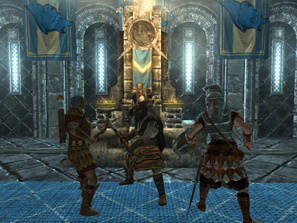
The Imperials Facing down the Stormcloaks in the Stormcloak fortress. Note the sbutle use of reds and blues to distinguish the two sides.
 The Imperials Facing down the Stormcloaks in the Stormcloak fortress. Note the sbutle use of reds and blues to distinguish the two sides. |
In Skyrim this opposition is supported visually with the Imperial color being red while the Stormcloaks wear blue so as to make them easy to distinguish and to give the player visual cues to know who’s their ally or enemy at any given moment. The two Imperial soldiers are also given many visual Imperial Roman motifs to solidify in the players mind their position of authority while the Stormcloaks are given more rebelious and wild looking armor to signify their opposition to authority.
|